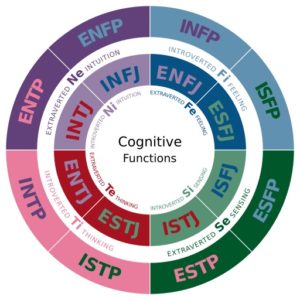What are Cognitive Functions?
Carl Jung is considered a founder of modern psychology. In his studies, he discovered eight basic types of people. Each type was said to have a particular cognitive function, such as Introverted Thinking (known as “Ti” in some places). Introverted thinkers consisted of both INTs and ISTs (introverted intuition thinkers and introverted sensation thinkers). Jung also recognized that a person may favor their perception function or their judgement function. The perception functions are Intuition and Sensation, and the judgement functions are Feeling and Thinking. So, there would actually be two types of introverted thinkers, or INTs: one would favor Intuition, and the other would favor Thinking, each following a different pathway of functions.
Getting 16 Types from 8 Cognitive Functions
Katharine Briggs and Isabel Myers saw this, and decided to clarify things. They created a questionnaire that incorporated the Judgement and Perception attitudes. This allowed for INTJs and INTPs, as well as Js and Ps of the other types. This increased the number of types to 16.
While some contest that Jung did not envision 16 types, there is ample evidence from his book, Psychological Types, to indicate that he did recognize 16 patterns of cognition. Because of this, I will refer to each of these 16 types as Jungian types.

Cognitive Function Dynamics
Each person has a type, expressed in 4 letters. Each type has 4 different cognitive functions that are of greatest significance to them: the primary function, the secondary (or auxiliary), the tertiary, and the inferior, also called the shadow. As a person experiences growth over the course of their life, they are expected to reach deeper into their psychological processes. This results in moving from perfecting our strengths to adapting to ways of thinking, feeling, and behaving that are less natural for us. A person of high psychological health is able to draw on the strengths of not only their primary and secondary functions, but their tertiary and inferior functions, as well.
Shared Functions
Each Jungian personality type has three other types that share its same functions, but arranged in a different order of preference. The first is a type that is very similar: for extraverts, it’s the introverted version of their type, and for introverts, it’s the extraverted version. This type is one of the two types characterized by a person’s secondary function. In fact, when speaking of the secondary function playing a role, we can generally consider it to be acting as this type, which is so close that we can slip into it without thinking; it’s literally second nature to us.

The second and third matches are types that are quite different to our type, one being the inverse of every trait, and the other being opposite in extraversion or introversion. For an INTP, these matches would be the ESFJ and ISFJ, respectively). The type that is the complete opposite of your type is also one of the types that fits into your inferior function. In fact, because it is so unlike you, when considering your inferior function, it is best to assign it this type. It is the epitome of all we see as different from us in terms of psychological types. Interestingly enough, it’s partner is one of the types comprising your tertiary function. In fact, because of this network of similarity, you should probably put the “tertiary” hat on this type rather than the other. The other would be the ISTJ, which, while still an Introverted Sensing type, shares only two functions with INTP. Meanwhile, ISFJ shares them all.
How does this help me?
Looking at our secondary, tertiary, and inferior sides as types rather than functions allows us to understand them a bit more clearly. We can now personify them better, and imagine ourselves in each of these roles. It also makes it a little easier to see that, over time, we can truly transform our weaknesses into strengths.
Do you know your type?
If you’ve ever taken the MBTI or Keirsey Temperament Sorter, you’ve been assigned a 4-letter personality type. The Trait Spectrum is a similar test, with some significant differences. We believe it is more accurate than other tools of its type. So whether you’ve had your type identified in the past or not, you can find it out now for free. Follow this link to take the Trait Spectrum test.
If you’d rather learn more about the Trait Spectrum and its applications for personal and team growth, check out this article: Introduction to Developer Level and the Trait Spectrum.


Carl Jung never said you could only use 4 cognitive functions, but rather 8, MBTI says we have a “normal” preference for 4, but that can change because of “nurture”. But dominant functions are prone to not change, auxiliaries are hard to change and tertiary and last function are developed as a young adult.
Lenore Thomson likes to depict the 8 functions as crew hands on a ship, with the captain as the dominant function. I don’t think Jung would support the idea of a different number of functions than 4 entering play at one time, since the omission or introduction of a function would result in an uneven number, creating a massive cognitive imbalance. However, in serious conflict, a type may become unconscious, leaving room for a different one to emerge. Thus, all 8 functions may have a role in guiding the creature, as they switch in and out, though many of them remain unconscious, or even dormant, for most of a person’s life, and the ones that emerge into consciousness during conflict will customarily retreat to unconsciousness once the conflict has been resolved, leaving their posts to the regulars.